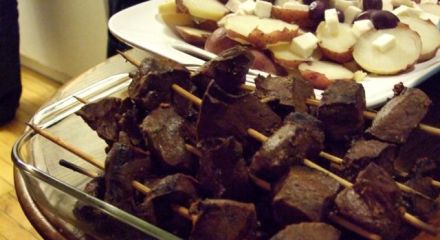Pastel de Choclo
Pastel de choclo (“corn cake”) is a dense, savory cake that combines the salty-sweetness of corn muffins, the density of meatloaf, and the layering of shepherd’s pie. It involves a layer of ground corn cooked over a layer of pino (seasoned ground beef), often baked in a paila, a thick earthenware bowl. A vegetarian version can be prepared by omitting the pino and cooking the ground corn as a solid cake. Pastel de choclo is indigenous to both Peru and Chile, where large-grained white choclo (Quechua for fresh white corn) is plentiful. Since it is often eaten cold and has a dense, solid consistency, it is a common “street food” sold from the stands of food vendors.
Anticuchos
Ah, anticuchos. The thought of them brings me back to childhood, and the slightly acidic aroma of the marinade sizzling over charcoal conjures up memories of family picnics in the park in Canada where, despite all the talk of multiculturalism, we were reminded of how foreign we were. Nothing quite says “not from around these parts” like barbecued organ meats, eh? In a nutshell, anticuchos is a grilled meat dish, made by marinating cubes of beef heart in a strongly acidic marinade and then grilling them on skewers.
Ceviche de Pescado
It’s currently 37ºC in Berlin, and the last thing I want to do is turn on the stove. I just made ceviche this afternoon (although the pictures date from an earlier version back in Chicago), and so I was inspired to put together this recipe while the fish marinates. This ceviche was made with corvina, but it can be adapted to nearly any sort of seafood by changing the marinating time and the contents of the marinade.
Mango-Jalapeño Salsa
Considering that I got the title for this blog from a pun on a culinary technique and a…erm…”corporeal technique” (hint: both techniques involve getting soaked), why not make the inaugural recipe one about macerating? To be clear: maceration involves softening or breaking up a food by soaking it in liquid. In this case, we’re using the mango’s own juices (drawn out by a bit of salting) along with some lime juice to soften it into a sticky-spicy-sweet salsa that goes great with salty tortilla chips. This recipe is entirely my own invention, but it uses the principles of any Latina salsa.



